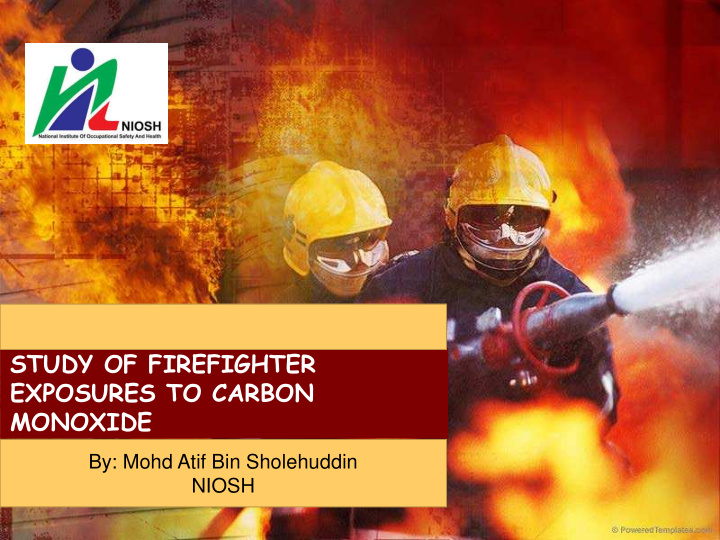



STUDY OF FIREFIGHTER EXPOSURES TO CARBON MONOXIDE By: Mohd Atif Bin Sholehuddin NIOSH
I NTRODUCTI ON
INTRODUCTION • Carbon monoxide – product of incomplete combustion • Also known as “silent killer’ among OSH Practitioner • Because the gas occur during fire, firefighter have high potential to have carbon monoxide poisoning • The purpose of this study is to study firefighter exposure to carbon monoxide during firefighting
CARBON MONOXIDE • Carbon monoxide is a toxic product generated from incomplete combustion (Claire Austin, 1997) • Incomplete Combustion Reaction 2C + O 2 2CO 1kg C + 4/3 O 2 7/3 CO • Carbon monoxide is a radical
CARBON MONOXIDE • If inhaled, carbon monoxide disrupts the blood’s transport of, and intracellular use of, oxygen [Ernst, 1998]. • The resulting hypoxia can cause myocardial injury [Satran, 2005].
EFFECT OF CARBON MONOXIDE? • Every 23 seconds a fire in the United States requires the services of a career or volunteer fire department caused by sudden cardiac arrest (Drew Nord et al., 2011).
Cause / Contributing cause Source: Firefighter Fatalities in the United States, Rita F. Fahy, Paul R. LeBlanc, Joseph L. Molis, NFPA, June 2016
Duty Source: Firefighter Fatalities in the United States, Rita F. Fahy, Paul R. LeBlanc, Joseph L. Molis, NFPA, June 2016
CARBON MONOXIDE • Thus, a fast technique to detect carbon monoxide poisoning are needed. • Detection of %COHb in blood using noninvasive measurement technique using MASIMO Rad-57 (CDC, 2011).
THE SOLUTI ON
MASIMO Rad-57 • Continuous monitoring in a portable, handheld device • Rugged and lightweight, ideal for field or hospital settings • Quick and easy to use
MASIMO Rad-57 • A medical first – noninvasive measurement of %COHb • Direct Reading using UV light
RESULT AND DI SCUSSI ON
RESULT AND DISCUSSION Carbon Monoxide Monitoring Analysis Groups Count Sum Average Variance start 181 1080 5.966851 9.654451 fire 181 1236 6.828729 10.83161 end 181 1215 6.712707 12.52812 Ave start < Ave fire and Ave fire > Ave end ANOVA was used to further analyse the data
RESULT AND DISCUSSION Carbon Monoxide Reading Summary Null Hypothesis: There is no significant changes between reading taken during duty report (start), after firefighting (fire), and duty end (end). H start = H fire = H end
RESULT AND DISCUSSION Carbon Monoxide Reading Summary ANOVA Result Source P- of SS df MS F value F crit Variation Between 79.19 2 39.59 3.60 0.03 3.01 Groups Within Groups 5942.55 540 11.00 6021.74 542 Total
RESULT AND DISCUSSION Carbon Monoxide Reading Summary Result: F = 3.60 > F crit = 3.01 H start ≠ H fire ≠ H end H null rejected P-value = 0.03 < 0.05 (significant) The changes of carbon monoxide reading between time taken is SIGNIFICANT
RESULT AND DISCUSSION Carbon Monoxide Reading Summary The changes of carbon monoxide reading between time taken is SIGNIFICANT. It means the firefighters are EXPOSED to carbon monoxide during firefighting.
CONCLUSI ON
CONCLUSION • There is significant increase of carbon monoxide reading among firefighters after firefighting activity. • Control measure such as health monitoring and equipment inspection should be implemented.
Thank You
Recommend
More recommend